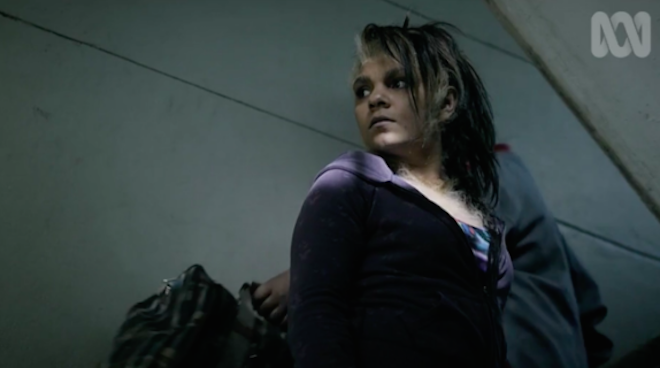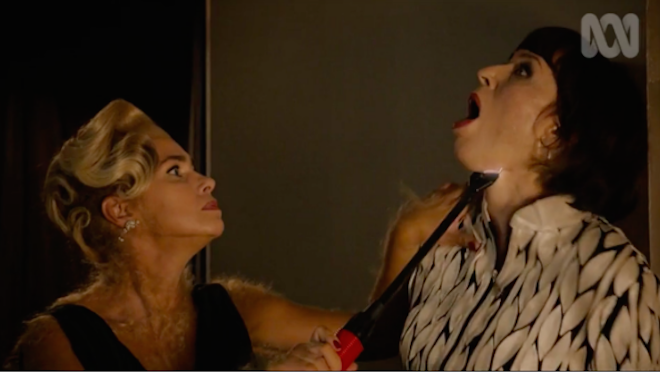Season One Debrief: Was ‘Cleverman’ Everything We Wanted It To Be?
"For me, the biggest thing was seeing my son pretend that he is the Cleverman when playing in his room," says the show's creator Ryan Griffen.

This post discuses plot points from the first season of Cleverman.
–
When the Cleverman finale aired a couple of weeks ago, within the space of days — barely more than a day apart, in fact — we saw two more high-profile acts of appalling violence by American police, resulting in the deaths of two black men. This context gave the violence in the finale even more resonance — particularly Waruu’s apparent killing of Maliyan (I say apparent, because last time someone was shot through the chest on this show he was walking around wincing the next day, and creator Ryan Griffen wouldn’t confirm whether we’ll see the character next season) and the brutal execution of the bearded Hairy youth who tries to run through the checkpoint.
The show isn’t leaning too hard on the parallels, but when a guard in a heavily militarised uniform shoots a young man and his body lies out in the open for all to see, whether as a warning or out of contempt, the resonance is clear. Seeing this, it’s tough not to think of Michael Brown, or — well, there are a fair few to choose from, so pick whatever footage of a dead black man on the ground comes to mind first.
Griffen says the scene in Cleverman wasn’t a deliberate evocation of those grainy online images, so much as it’s just a sight that’s so familiar as to be unavoidable. “This scene wasn’t written to reference this in particular; rather it was included to illustrate how minorities are treated in general,” he says. While there’s an Australian specificity to the storytelling and setting, the show was always intended to have resonance beyond Indigenous issues here.
“The key for us was making sure the Hairies were not only an allegory for a black/white story. We wanted them to be a marginal group that could find easy comparison to — and understanding from — anyone who has had an experience as the ‘other’,” he says. “For me personally I do see obvious parallels to the early colonisation story but that’s because it’s so specific to my own experience as an Indigenous man.”
“Our hope was that all audience members could relate to the Hairies one way or another. Whether that be as members of the LGBTQI community or refugees, or anyone who has ever felt different, peripheral or unusual.”
Was Maliyan “a cancer”, as Waruu insists? Aside from Boondee, who we haven’t seen lately (although perhaps he can be assumed to be safe for now if the Hairy subjects in Slade’s lab were just having saliva extracted) he was the proudest Hairy character that we got to know through the season. His hairstyle (which was echoed by Latani’s when she arrived in the Zone — keep in mind how politicised black hair and hairstyling is in the real world), his attitude, his fierce protection of his people and the way he took Djukara, Kulya and Mungo under his heavily armed wing… These are legitimate expressions of pride and resistance, as well as survival strategies, when you are treated as a third-class citizen.

To those who see being a certain kind of person as nothing to be proud of, pride in that identity all too often reads as a dangerous, unjustified arrogance. And while it’s true that the rage of oppressed and beaten-down people can sometimes manifest itself as violence in service of either change or simply expression, the way that violence is handled by people in power can make all the difference, depending on whether they only see the symptom, or actually listen when they’re told what’s really wrong.
As in many superhero stories, the ways that individuals and authorities use violence is not only a key theme but also a way of drawing parallels and distinctions between characters. Koen and Waruu both have tempers — their fire-lit fight in the penultimate episode was one of the highlights of the season — but ultimately Koen just wanted to keep his head down and live his own life. He tended to avoid conflict and violence until it was necessary for the greater good. (Remember him scoffing at Blair’s suggestion that they should have a gun in the premiere?)
This might stem in part from his childhood in The Zone — it’s well-established as a place where safety is relative, and thanks to Waruu’s anger and Linda’s guilt and distance, the Wests’ home life wasn’t the most secure either. Waruu tormented Koen as a child, and has a nasty streak as an adult that clearly existed before the series started (hi, Belinda) but really began to reveal itself as it went on, as shown by Nerida’s horror at his GoPro footage.

“Superheroes need to be selfless and the ‘no kill’ rule is important, but our superhero is human and flawed,” says Griffen. The willingness to kill other humans, innocent or otherwise, is often a trait that separates superheroes from the villains they fight — particularly the ones who are driven by what they see as good intentions but whose moral compass has been confused by personal trauma, mental illness or neon green mystery goo.
Waruu doesn’t need Hairy Juice to reveal his nastiness. He wasn’t on it when he told Linda he was glad she has cancer. And his use of that word, echoing that conversation, to describe Maliyan suggests that Waruu has a serious case of the Who-Are-You-Really-Mad-Ats. Between his resentment of his half-brother and his anger at his mother, he’s clearly still fuelled in part by rage and helplessness over his father’s infidelity and death. As much as he wants to help his people and the Hairies (and to be seen to be helping) Waruu’s ego is still his driving force.
“Waruu means Crow and his story arc follows the traditional Dreaming story of The Crow,” explains Griffen. “His actions arise from jealousy more than anything else. His want for power is the strongest desire he feels.” Koen’s moral compass, Griffen adds, has already gone through some important changes — but he’s not necessarily going to turn into a pure-hearted hero overnight, and Waruu’s character is similarly unlikely to lose any of the dimension the writers, and Rob Collins’ performance, has built into it.
There are however some endings in the finale — to the arc of Koen accepting his role as Cleverman, to the threat of the Namorrodor, to the return of Kora to her realm, and, most satisfyingly, to the horrible forced-prostitution storyline. Continuing Tasma Walton’s season of seriously incredible eye acting, there’s a fascinating nuance to Araluen’s expressions — first the thousand-yard stare when she’s determinedly getting Matthews off, and the second as she watches the news from The Zone (including the drone shot of Latani, and the chilling visual of the Hairy boy’s body lying on the ground) and goes from massaging him to choking him out.
Frankie, as I hopefully predicted, gets the cattle prod to the neck, and Araluen’s blonde colleague gives her a hoodie to make her escape — another garment with a lingering political resonance, and the same one that helped her Latani hide on her journey to the Zone.

It’s difficult to judge the narrative success of Cleverman’s first season when it ends feeling like it’s just getting going. Good thing we already know we’re getting a second season — getting us all hopped up on monster killings and molotovs only to leave us sweating at the barricade with The Zone residents, would have been even more unsatisfying had the next chapter not been locked in already. (Griffen admits some of the battle scene was shot, but ultimately held over for the next season to keep the story open.)
Starting the season with a battle is a ballsy choice, and it could be hard to build on for six more episodes. More than that, the logistical plausibility of certain plotting choices (like Slade privatising an armed wing of the Immigration Department overnight) will need some serious backing up. There also needs to be more work done to establish the broader context for the Hairies, and what happened in the six months between Emergence Day and when the series begins, and Griffen says the world of the show will see some expansion in the second season to start to provide that wider view.
But as dark as it’s gone at times, and for all its flaws, Cleverman has ultimately been a positive force. “We have had people asking about Aboriginal culture, fans looking to learn more about the languages our characters speak in the show and we have some amazing fan art being made,” says Griffen. “But for me the biggest thing was seeing my son pretend that he is the Cleverman when playing in his room. To see the show empower him was my biggest goal, and we managed to achieve it.”
–
You can watch the Cleverman finale on iView now.
–
Caitlin Welsh is a freelance writer who tweets from @caitlin_welsh.

